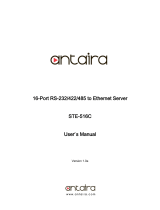
UDS2100 User Guide 4
Serial Port Connection ___________________________________________ 36
Exiting Setup Mode _________________________________________________ 37
6: Setup Mode: Server Configuration 38
Server Configuration (Option 0)________________________________________ 38
IP Address________________________________________________________ 38
Set Gateway IP Address _____________________________________________ 38
Netmask: Number of Bits for Host Part __________________________________ 39
Change Telnet Configuration Password _________________________________ 39
DHCP Name ______________________________________________________ 39
7: Setup Mode: Channel Configuration 41
Channel 1 (Option 1) ________________________________________________ 41
Baudrate _________________________________________________________ 41
I/F (Interface) Mode _________________________________________________ 42
Flow_____________________________________________________________ 42
Port Number ______________________________________________________ 43
Connect Mode _____________________________________________________ 43
a) Incoming Connection __________________________________________ 45
b) Response ___________________________________________________ 45
c) Active Startup ________________________________________________ 45
d) Datagram Type _______________________________________________ 47
e) Modem Mode ________________________________________________ 48
Send the Escape Sequence (+++) in Modem Mode ________________________ 50
Auto Increment Source Port __________________________________________ 50
Remote IP Address _________________________________________________ 51
Remote Port ______________________________________________________ 51
DisConnMode _____________________________________________________ 51
Flush Mode (Buffer Flushing) _________________________________________ 52
Pack Control ______________________________________________________ 52
Packing Interval ________________________________________________ 53
Trailing Characters ______________________________________________ 53
Send Characters ________________________________________________ 53
DisConnTime (Inactivity Timeout) ______________________________________ 54
Send Characters ___________________________________________________ 54
Telnet Terminal Type________________________________________________ 54
Channel (Port) Password ____________________________________________ 54
8: Setup Mode: Advanced Settings 55
Expert Settings (Option 5) ____________________________________________ 55
TCP Keepalive time in seconds ____________________________________ 55
ARP Cache timeout in seconds ____________________________________ 56
Disable Monitor Mode at bootup ____________________________________ 56
HTTP Port Number ______________________________________________ 56
MTU Size _____________________________________________________ 56
Enable alternate MAC____________________________________________ 56
Ethernet connection type _________________________________________ 56
Security Settings (Option 6)___________________________________________ 57
Disable SNMP__________________________________________________ 57
SNMP Community Name _________________________________________ 57
Disable Telnet Setup_____________________________________________ 57























